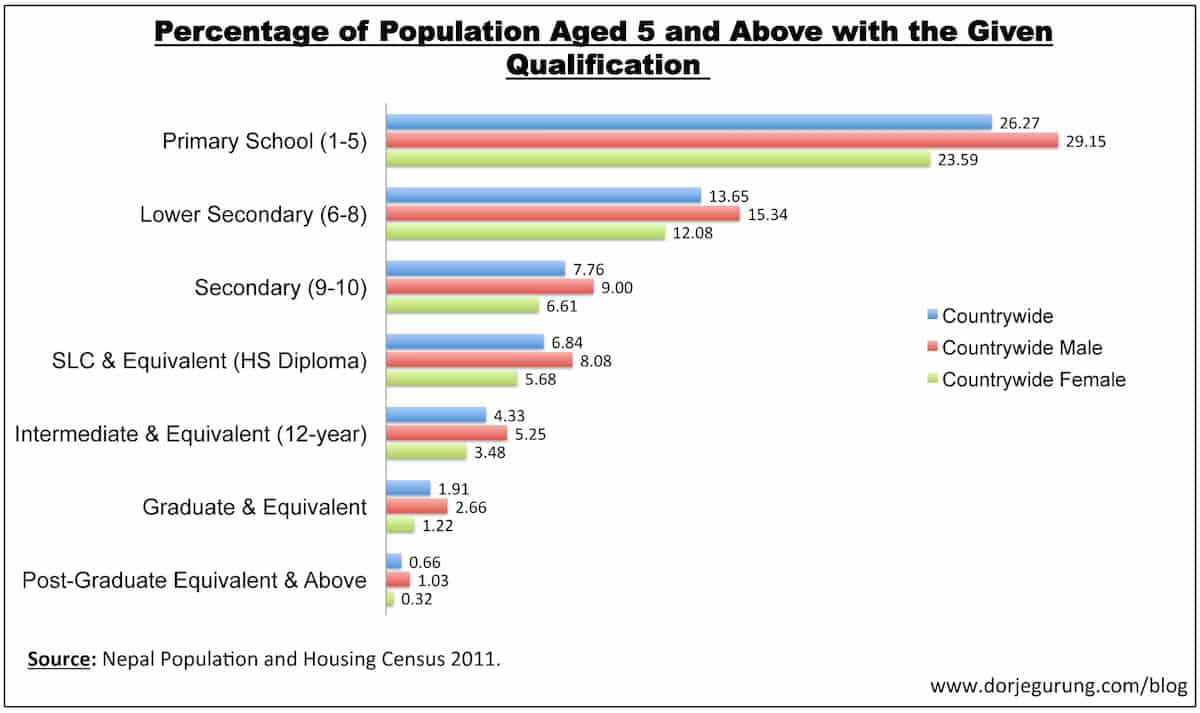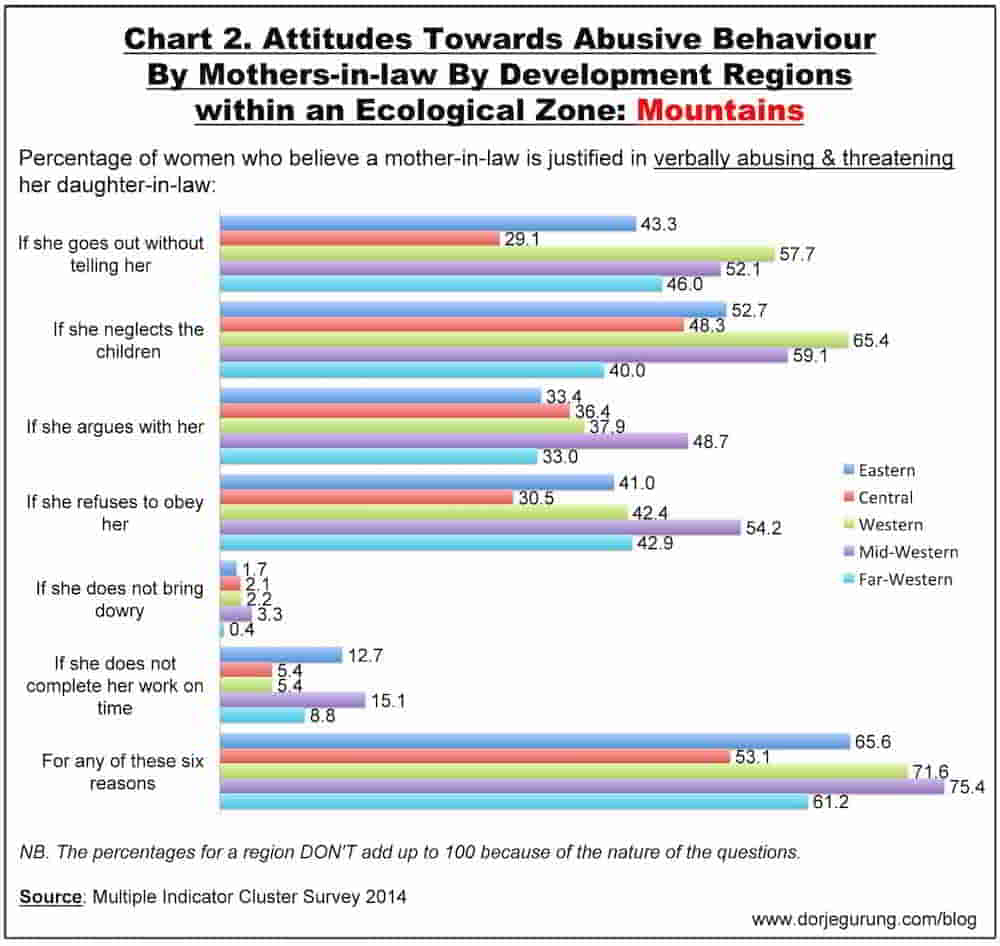This is the fourth blog post in the series summarizing some results of the Multiple Indicator Cluster Survey (MICS) 2010 and 2014.
In the first one “Let’s Raise Children Who Won’t Have to Recover From Their Childhoods” reproducing results of child disciplining methods in the country, I argued how we are raising children who will have to recover from their childhood but that there are alternatives. In Child Discipline Methods in Nepal By Regions, Zones etc. I produced charts showing how child discipline methods vary around the country. In Nepal: Patriarchy-Shaped Laxed Attitudes Towards Wife-beating I reproduced 2014 survey results showing just that and discussed how to tackle that as a nation.
One of the rituals in a Hindu wedding ceremony in Nepal symbolizes the “death” of the bride. I suspect the ritual serves as a confirmation and reinforcement of the belief that, having given her hand in marriage to a man — yes, most marriages in Nepal are still arranged — and his family, she now “belongs” to them!
Furthermore, while in her own family, her father and other members of her immediate family would have played a significant role in her life, in her new home, those roles transfer to her husband and her mother-in-law. As for responsibilities, in addition to raising her own family with her husband, she is also expected help her husband look after his family!
A women in Nepal, therefore, potentially faces domestic violence not just from her husband, but, interestingly enough, also from her mother-in-law!
Domestic violence against women in the country is pretty dire. To reinforce that, I reproduce something I shared in Nepal: Patriarchy-Shaped Laxed Attitudes Towards Wife-beating.
In the Societal Violence Scale (SVC)Nepal, in 2014, scored a 5 out of 5. (The higher the score, the more violent a society.) Here’s the descriptor for level 5:
Violence against members of the group is ubiquitous in scope and egregious in nature. It affects a large proportion of the population of the group and assumes a variety of forms. [Emphasis mine.]
What follows are charts summarizing the attitudes of women towards her mother-in-law verbally abusing and threatening her daughter-in-law. While the pattern is pretty much the same as their attitudes towards wife-beating, they are considerably more laxed!
(Incidentally, one of the reasons for the preference of boys is their social security role for aging parents. But of course, the son “takes care” of his parents by bringing home a wife…to do a lot of the work! I have heard that, more and more daughters are taking care of NOT only the parents of their husbands, but also their own! I would love to see a study of the rate at which women are stepping in for their brothers.)
Here’s their attitude towards abusive behavior by mothers-in-law broken by area.
The following chart shows the difference in attitude by education level.
 Sadly, as I pointed out in the other blog post about women’s attitude towards wife-beating, higher level of education among women in the country is abysmally low as you can see from the chart below. About 89% of Nepali women don’t have more than a high school diploma (SLC and Equivalent)!
Sadly, as I pointed out in the other blog post about women’s attitude towards wife-beating, higher level of education among women in the country is abysmally low as you can see from the chart below. About 89% of Nepali women don’t have more than a high school diploma (SLC and Equivalent)!
The following shows variation in attitude by wealth.
Education level and wealth, I am sure, partly, if not entirely, explains the significantly different attitudes of women in Kathmandu Valley and the Central Region — where the valley is located — from the rest. The valley probably has the highest concentration of the educated and wealthy in the country.
And attitude by marital status is as one would expect.
The country is extremely diverse geographically, culturally and ethnically. Geographically, it is divided into three Ecological Zones, and politically into five Development Regions as shown below.
Again, as pointed out in the other blog post in the series, there is obviously significant variations in culture, ethnicity, as well as the local economy between Regions and Zones.
That variation is also, of course, reflected in the attitudes (and behaviors) of the people, including women’s attitudes towards abusive behavior by mothers-in-law.
The following two charts show that variation by Development Region and Ecological Zone.
The following three charts show the variation in attitudes among Development Regions within each of the Ecological Zones.
There you have it.
As for the solution, I have discussed that at length in Nepal: Patriarchy-Shaped Laxed Attitudes Towards Wife-beating.
What do you think?
References
Added after the publication of the blog post.
Click here for a short video containing the most up-to-date data and commentary by Meera Dhungana, an advocate, posted less than a week ago! [Added Sept. 28, 2018.]
The Record (Sept. 2017). Violence against women in Nepal is intensifying. [Added Sept. 28, 2018.]
The Record (March 28, 2018). Why does rape have a low conviction rate in Nepal? [Added Sept. 28, 2018.]
The Record (April 2, 2018). Rampant domestic violence goes unpunished. [Added Sept. 28, 2018.]
Mahila Khabar (Female News). महिला मन्त्रालयको चरम लापरबाहीः प्रतिवेदनसँगै हरायो शीघ्र न्याय. This year. based on based on cases reported — I repeat, REPORTED — to the police, on average 34 women suffer from domestic violence DAILY! Given the stigma against BEING A VICTIM OF DOMESTIC VIOLENCE AND NOT A PERPETRATOR, I am willing to wager that, even by my very very conservative estimate, the actual number is at least 3X that! [Added Sept. 28, 2018.]
The Kathmandu Post (Sept. 29, 2018). More women report domestic violence. “J had been married for 20 years, during which she was subjected to relentless domestic violence. She never got along with her mother-in-law and often had to endure her husband’s drunken behaviour.” […] “The findings of the women’s commission are similar to the findings of the most recent Nepal Demographic Health Survey, which showed that nearly a third of all married women in Nepal had experienced some kind of physical, emotional and sexual violence from their husbands.” [Added Oct. 2, 2018.]










